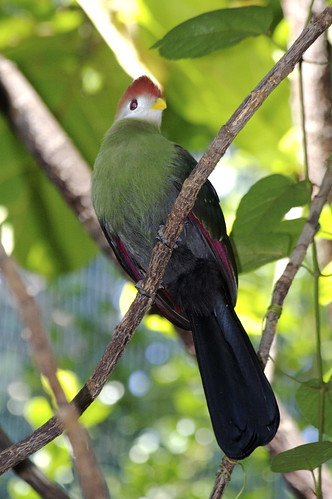tags: Red-crested Turaco, Tauraco erythrolophus, birds, Image of the Day
Third in a series of non-passerine images by this photographer.
The turacos are classified into the bird family Musophagidae, which translates as "banana-eaters". Musophagidae also include the plantain-eaters and go-away-birds. Musophagidae are medium-sized arboreal birds that are endemic to sub-Saharan Africa. They live in forests, woodland and savanna. They have weak flight but run quickly through the tree canopy. Musophagidae are primarily frugivorous; feeding mostly on fruits, although they also will consume leaves, buds, and flowers, and animals prey, such as small insects, snails, and slugs. Turacos and go-away-birds are commonly known as "louries" in southern Africa.
Musophagidae are semi-zygodactylous; their fourth, or outer, toe can point either forward or backwards, while the second and third toes always point forward, and are conjoined in some species. Musophagidae often have prominent crests and long tails. Go-away-birds make piercing alarm calls that alert other fauna to the presence of predators or hunters; hence, their common name.
Unlike their more plainly colored relatives, turacos are noted for their peculiar and unique pigments that give them their bright green and red plumages. Their green color is produced by turacoverdin, the only true green pigment identified in birds. Red colors of turaco wings are due to the red pigment, turacin (red colors in most other birds is due to the presence of pigments produced from carotenoids). Both turacoverdin and turacin are derived from porphyrins and currently known only from the Musophagidae.
There are eighteen species of turacos, all of which are monomorphic, although sexes can be distinguished by bill color. They are monogamous, making an untidy nest of twigs, commonly laying 2-3 whitish eggs, and they feed their nestlings on predigested fruit.


Hi from the UK. One other thing about turacos is that they seem to be quite intelligent. I know someone with a pet turaco and although they cannot talk they can learn routines - I have been at 2 zoos where they were used in bird displays.